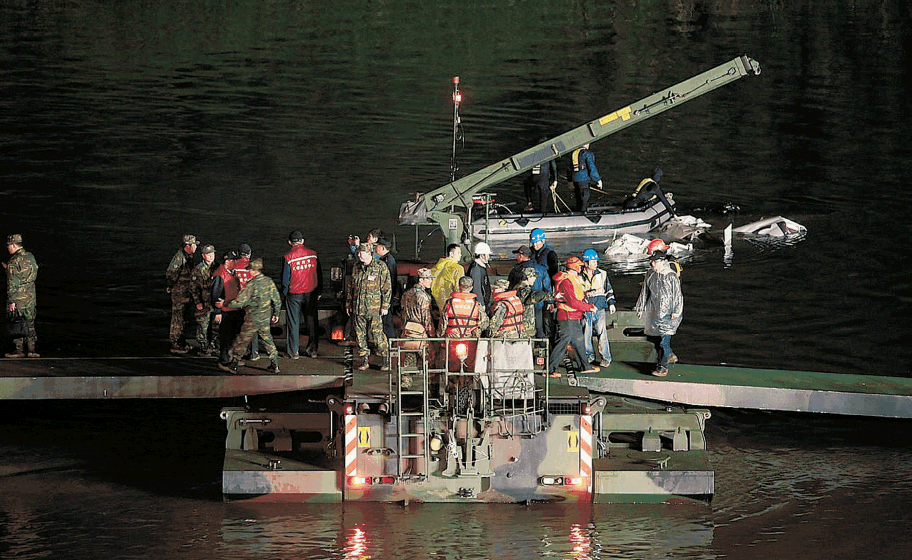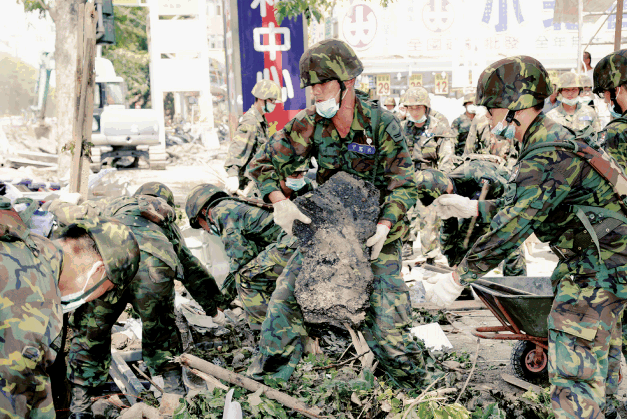- Minister's Foreword
- Introduction
- Part 1. Strategic Environment
- Part 2. National Defense Policy
- Chapter 3. National Defense Policy Plans
- Chapter 4. National Defense Policy Implementation
- Section 1. Enhance Force Buildup Efforts
- Section 2. Devise Well-planned Transformation of Military Service
- Section 3. Reform to National Defense Legal System
- Section 4. Safeguard Military Human Rights
- Section 5. Expand Military Exchanges
- Section 6. Enhance Crisis Response
- Section 7. Improve Care for Service Members
- Section 8. Promote Gender Equality
- Part 3. National Defense Capabilities
- Chapter 5. National Defense Force
- Section 1. Introducing the National Defense Organization
- Section 2. Improving Joint Operations Effectiveness
- Section 3. Maintaining Continuous Operational and Training Readiness
- Section 4. Consolidating Information and Electronic Warfare Capabilities
- Section 5. Refining Logistics Support
- Section 6. Consolidating Reserve Force
- Section 7. Forging Intangible Combat Capabilities
- Chapter 6. National Defense Resources
- Chapter 5. National Defense Force
- Part 4. All-out Defense
- Appendixes
In order to defend our country and fellow citizens, the ROC Armed Forces have been vigorously making preparations for disaster prevention and relief operations against the threat of complex disasters. Following the guidelines that disaster relief is akin to fighting a battle and that avoidance is better than prevention, and prevention is better than rescue, we have been adopting active measures, such as forward deployment, early stationing, and instant reaction for disaster relief efforts, so as to strengthen the ROC Armed Forces'
performance in disaster relief and assistance provided to the overall disaster prevention and relief efforts in compliance with the law.
I. Implementation Status
( I ) Aspect of Disaster Prevention:
1.Raising disaster prevention awareness: For the past 2 years, the ROC Armed Forces have been providing extensive assistance to local governments in disaster evacuation efforts as well as promoting the guideline that avoidance is better than prevention, and prevention is better than rescue. By so doing, we have been successively rectifying the people's awareness of disaster prevention from betting on chances to active avoidance.
2.Establishing disaster prevention guidelines: The ROC Armed Forces have been adhering to the guidelines of forward deployment, early stationing, and instant reaction for disaster relief efforts. Lessons learned in recent years demonstrated that by following the guidelines, we can successfully complete the disaster relief operations and reduce the losses of lives and properties of our fellow citizens.
3.Strengthening communication and coordination: The ROC Armed Forces shall assign liaison officers to local governments 36 hours before a typhoon lands in order to establish communication channels between military commanders at all levels and heads of local governments. Our disaster prevention efforts have been well-received by the heads of local governments as well.
4.Stocking rescue supplies: We have kept a stockpile of equipment and items for 7 battalions to conduct disaster relief efforts in northern, central, southern, and eastern areas of Taiwan. A protocol of preparation of disaster relief supplies has been signed with the Red Cross Society of the ROC to jointly stock disaster relief supplies.
( II ) Aspect of Implementation Approach:
1.Procuring disaster relief equipment: We have been picking out items from our operational inventory that may have a dual use in disaster relief, and acquiring 13 operational items of dual use in supporting our disaster relief missions, such as UH-60M utility helicopters, AAV-7 amphibious assault vehicles, and biological agent detection vehicles, etc.
2.Nurturing disaster relief instructors: We have arranged disaster prevention and relief courses in the curriculums of operational training and academic education. For the purpose of nurturing instructors, selected service members from the Marine Corps, Special Forces, and engineering units were assigned to participate in relevant disaster relief courses provided by the Fire Department, the Red Cross Society, and the other aquatic search and rescue teams in order to further develop their disaster relief skills and professional competences. To date, 1,240 individuals have undergone those courses.
3.Strengthening medical care operations: Since 1997, the ROC Armed Forces have been providing EMT1, EMT2, and EMTP paramedics training courses through which 800 individuals are trained every year. From 2014 to August 2015, 6,443 individuals have undergone the courses. Currently, 8,865 service members have been successfully certified as paramedics, greatly improved our disaster and emergency rescue capabilities.
4.Establishing a disaster prevention platform: To improve collaboration between the ROC Armed Forces and regional disaster prevention efforts, we have been following the plans made by the Central Disaster Prevention and Response Council of the Executive Yuan and all-out defense mobilization meeting to carry out all-out defense mobilization and disaster prevention and relief exercises directed by the local governments. These exercises are used to establish a disaster prevention coordination platform capable of establishing situational awareness, implementing quick emergency responses, rapid handling, and effective containment of disasters.
5.Improving overall search and rescue capacities: Since June 2015, we have been transferring 15 UH-60M utility helicopters in batches to the National Airborne Service Corps of the Ministry of the Interior, helping to improve the government's overall search and rescue capacities.

When faced with threats of disasters with increasingly complex and ever-changing nature, the ROC Armed Forces have been holding the guideline that disaster relief is akin to fighting a battle to improve their disaster relief performance. The picture shows that the ROC Armed Forces assisted in a search and rescue mission for crash of an airliner of TransAsia Airways.

Based on the current foundation, the ROC Armed Forces have been improving themselves through revising the disaster relief doctrines, integrating disaster prevention resources so as to achieve the goal of full preparedness. The figure shows that the ROC Armed Forces assisted in disaster relief operations for the Kaohsiung gas explosion disaster.
II. Relief and Rescue Results
From 1 January 2014 to 19 August 2015, the ROC Armed Forces have conducted 102 multiple emergency search and rescue missions and assisted in 10 major disaster relief operations for incidents as follows: Typhoon Matmo, Typhoon Fung-Wong, Typhoon Soudelor, the crash of TransAsia Airways Flight 222, the crash of TransAsia Airways Flight 234, 2014 Kaohsiung gas explosions, Formosa Fun Coast dust explosion, RV Ocean Researcher 5 distress, dengue fever prevention, and avian flu prevention. Totally, we have committed 64,400 personnel, 313 aircraft sorties, 217 vessel (and boat) sorties, 3,848 vehicles, and 5,090 pieces of machinery. Our efforts have helped evacuate 9,136 local citizens, provided medical treatment to 216 wounded individuals, transferred 125 wounded individuals to healthcare institutions, stacked 83,952 sandbags, removed 3,414.59 tons of debris and rubble, monitored traces of toxic fumes in
an area of 160 square kilometers, and carried out disinfection operations over an area of 91.774 square kilometers (per Appendix 8-1).
III. Approach Improvements
Facing the threat of complex disasters, the ROC Armed Forces have been revising and fine-tuning our disaster relief doctrines in accordance with our current foundation, integrating disaster prevention resources, conducting disaster prevention exercises, and expanding our exchanges on disaster prevention operations in order to achieve continuous improvements and the goal of full preparedness.
( I ) Revising Disaster Prevention Doctrines and Expanding the Scope of Responses Taken
By referring to the experiences and lessons learned from major disaster relief operations in recent years, we have revised 33 operational procedures and doctrines, such as Current Disaster Response Operational Procedures, Search and Rescue Operational Procedures, and Disaster Prevention and Relief Training Doctrine to improve joint relief and disaster prevention capabilities.
( II ) Integrating Disaster Prevention Resources and Improving Search and Rescue Capabilities
We have established the ROC Armed Forces disaster relief information system in cooperation with the Response Management Cloud System of the Ministry of the Interior, so as to create an information sharing platform with disaster prevention agencies, such as the Central Weather Bureau, the National Fire Agency, etc., as well as social organizations, such as the Red Cross Society, Tzu Chi Foundation, etc. Furthermore, we have been helping the National Airborne Service Corps to train its instructors for aircrews after reviewing the availability of the ROC Army Aviation and Special Forces Command 's UH-60M helicopter training sites and maintenance capabilities in order to expand sphere of resource sharing, and facilitate emergency rescue missions and operations.
( III ) Implementing Disaster Prevention Drills and Raising Awareness for Self-evacuation
To raise a broader awareness for the people's self-evacuation when disaster strikes, we have been conducting disaster prevention drills in local communities with particular focus on contingency command and control between local governments, personnel reinforcement, and disaster prevention and evacuation so as to establish a wide-area disaster relief mechanism.
( IV ) Deepening Disaster Prevention Exchanges and Diversifying Actions and Capabilities
The MND have reached substantive consensus with the US military concerning the exchanges of disaster prevention. In the future, both sides may assign personnel to observe in drills and exercises, attend disaster prevention simulations in between, and even take part in regional-level disaster prevention exercises. With the assistance from the US, we have been joining in some international humanitarian assistance programs, and we may by the way become an active player in global humanitarian assistance missions.
